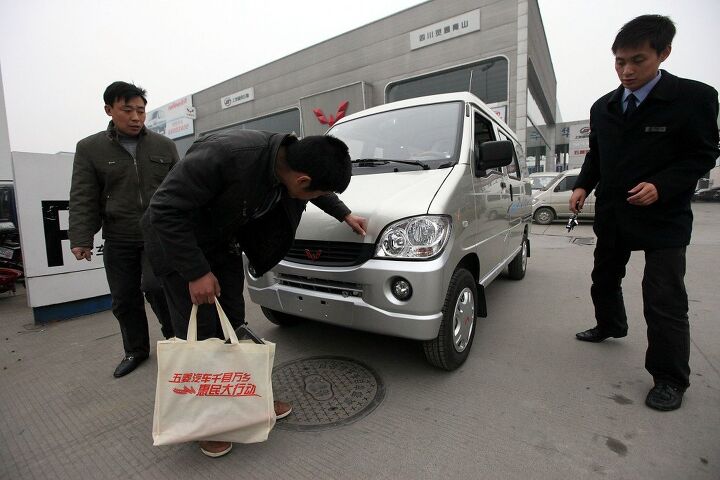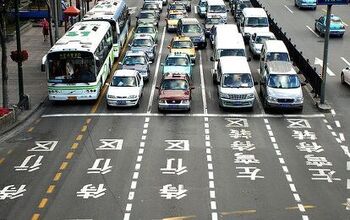China: 18 Million Cars. Now What?

From RenCen to Wolfsburg, all eyes are on China. Ok, so this year China will build and buy 18 million cars or thereabouts. But what about next year? Carmakers in Europe, Japan, and the U.S. are dependent on the Chinese growth machine. So what will it be? Boom or bust?
Already rattled by Beijing’s curb on new cars, stocks of German carmakers from BMW to Volkswagen took a nose-dive two days ago when the Chinese government announced that there will be no more tax incentives for new cars as of January 1, 2011. Well, not everybody at the German stock exchanges reads TTAC. If they would, the tax story would have not surprised them. The GM share (of a company with by far the most exposure to China) powered ahead. We have many readers at GM.
Well, the next day, the market realized that German automakers will be unhurt, and stocks recovered. Duh: If the tax hike hurts anybody, then it’s the (quasi) independents, such as Geely, Chery, or BYD. Why? The raised tax applies to cars of 1.6 liter and less. That’s not the playground of the big joint ventures.
And in any case: In 2009, the tax on cars 1.6 liters and less had been halved to 5 percent. January 1, 2010, the tax was raised to 7.5 percent. There were warnings of falling skies. China’s CAAM prognosticated moderate growth of 10 percent. Even TTAC was too conservative when we predicted 12 months ago that “China should close out 2010 with 15m, 16m, or more cars sold.”
And what did Chinese do? They listened neither to the CAAM, nor did they read TTAC, and they bought more cars in 2010 than any country on the globe, ever. So now the tax goes up from 7.5 percent to 10 percent. What’s 2.5 percent on a $5,000 car? $125. Big deal.
The Chinese government certainly didn’t suffer from the reduced taxes. While car sales rose some 30 percent this year “tax revenues from newly purchased autos jumped 53.3 percent from one year earlier to 156.92 billion yuan (23.77 billion U.S. dollars) in the first 11 months of 2010,” says Xinhua. Looks like more appetite for bigger cars anyway.
All eyes are on China, but not all see the same. The New York Times found a lawyer in Guangzhou who had plunked down $7,500 as a down payment on a $72,000 (incl. taxes) and who’s still waiting for his car, because Audi can’t keep up with the demand. Or because dealers sell the hot import at a premium over MSRP for immediate delivery.
There are others, such as USA Today, that see the Chinese market implode, “and that could eventually mean a flood of Chinese car imports into the U.S.” The yellow hordes, led by the Chevy Sail, no doubt. Don’t hold your breath.
Chinese automakers, from General Motors to Geely, think that “growing demand for cars in China will outweigh the impact from the end of tax incentives that boosted sales,” says Bloomberg. Pretty much all industry insiders in China agree with GM China’s Kevin Wale who expects the Chinese market to rise by 10 to 15 percent in the new year. Yesterday, Bloomberg called GM China and asked whether Wale had changed his mind. The answer was no.
Geely, maker of the QQ midgetmobile, is likewise optimistic. Lawrence Ang, Geely’s executive director, told Bloomberg that there is a loophole in the tax code. Fuel efficient cars still are sponsored by a 3,000 yuan ($450) subsidy, and “after some modifications, most small cars in China should be able to qualify.”
My take? A very simple one: There are anywhere between 1.3 billion and 1.5 billion (nobody really knows) people in China. Only 6 percent own a car. The rest wants one. Combine that with rising incomes, even for the lowly farmhand, and there are enough car buyers for decades to come. Sure, there will be the inevitable ups and downs, but the long term trend is up. (If there ever is a serious market tremor in China, it could bring GM down. Ford and Chrysler – if still alive- would gain.)
And to save you the typing of “housing bubble” – sure, there is one. Has been here for years. Is getting bigger by the day. Vacancy rates ginormous (nobody has real numbers.) However, in China you have to put down 30 percent for the mortgage on your first home. 50 percent for the second. All cash from here on out. There is no securitization of mortgages. A lot of the empty homes and mansions are paid for in full. If the real estate bubble pops (and it will,) there will be a giant redistribution of wealth. Isn’t that what communism is all about? ( Recommended reading here.)

Bertel Schmitt comes back to journalism after taking a 35 year break in advertising and marketing. He ran and owned advertising agencies in Duesseldorf, Germany, and New York City. Volkswagen A.G. was Bertel's most important corporate account. Schmitt's advertising and marketing career touched many corners of the industry with a special focus on automotive products and services. Since 2004, he lives in Japan and China with his wife <a href="http://www.tomokoandbertel.com"> Tomoko </a>. Bertel Schmitt is a founding board member of the <a href="http://www.offshoresuperseries.com"> Offshore Super Series </a>, an American offshore powerboat racing organization. He is co-owner of the racing team Typhoon.
More by Bertel Schmitt
Latest Car Reviews
Read moreLatest Product Reviews
Read moreRecent Comments
- Rna65689660 For such a flat surface, why not get smoke tint, Rtint or Rvynil. Starts at $8. I used to use a company called Lamin-x, but I think they are gone. Has held up great.
- Cprescott A cheaper golf cart will not make me more inclined to screw up my life. I can go 500 plus miles on a tank of gas with my 2016 ICE car that is paid off. I get two weeks out of a tank that takes from start to finish less than 10 minutes to refill. At no point with golf cart technology as we know it can they match what my ICE vehicle can do. Hell no. Absolutely never.
- Cprescott People do silly things to their cars.
- Jeff This is a step in the right direction with the Murano gaining a 9 speed automatic. Nissan could go a little further and offer a compact pickup and offer hybrids. VoGhost--Nissan has laid out a new plan to electrify 16 of the 30 vehicles it produces by 2026, with the rest using internal combustion instead. For those of us in North America, the company says it plans to release seven new vehicles in the US and Canada, although it’s not clear how many of those will be some type of EV.Nissan says the US is getting “e-POWER and plug-in hybrid models” — each of those uses a mix of electricity and fuel for power. At the moment, the only all-electric EVs Nissan is producing are the Ariya SUV and the perhaps endangered (or maybe not) Leaf.In 2021, Nissan said it would make 23 electrified vehicles by 2030, and that 15 of those would be fully electric, rather than some form of hybrid vehicle. It’s hard to say if any of this is a step forward from that plan, because yes, 16 is bigger than 15, but Nissan doesn’t explicitly say how many of those 16 are all-battery, or indeed if any of them are. https://www.theverge.com/2024/3/25/24111963/nissan-ev-plan-2026-solid-state-batteries
- Jkross22 Sure, but it depends on the price. All EVs cost too much and I'm talking about all costs. Depreciation, lack of public/available/reliable charging, concerns about repairability (H/K). Look at the battering the Mercedes and Ford EV's are taking on depreciation. As another site mentioned in the last few days, cars aren't supposed to depreciate by 40-50% in a year or 2.


































Comments
Join the conversation
Boom!!!11!1!1. 22 million or more next year.